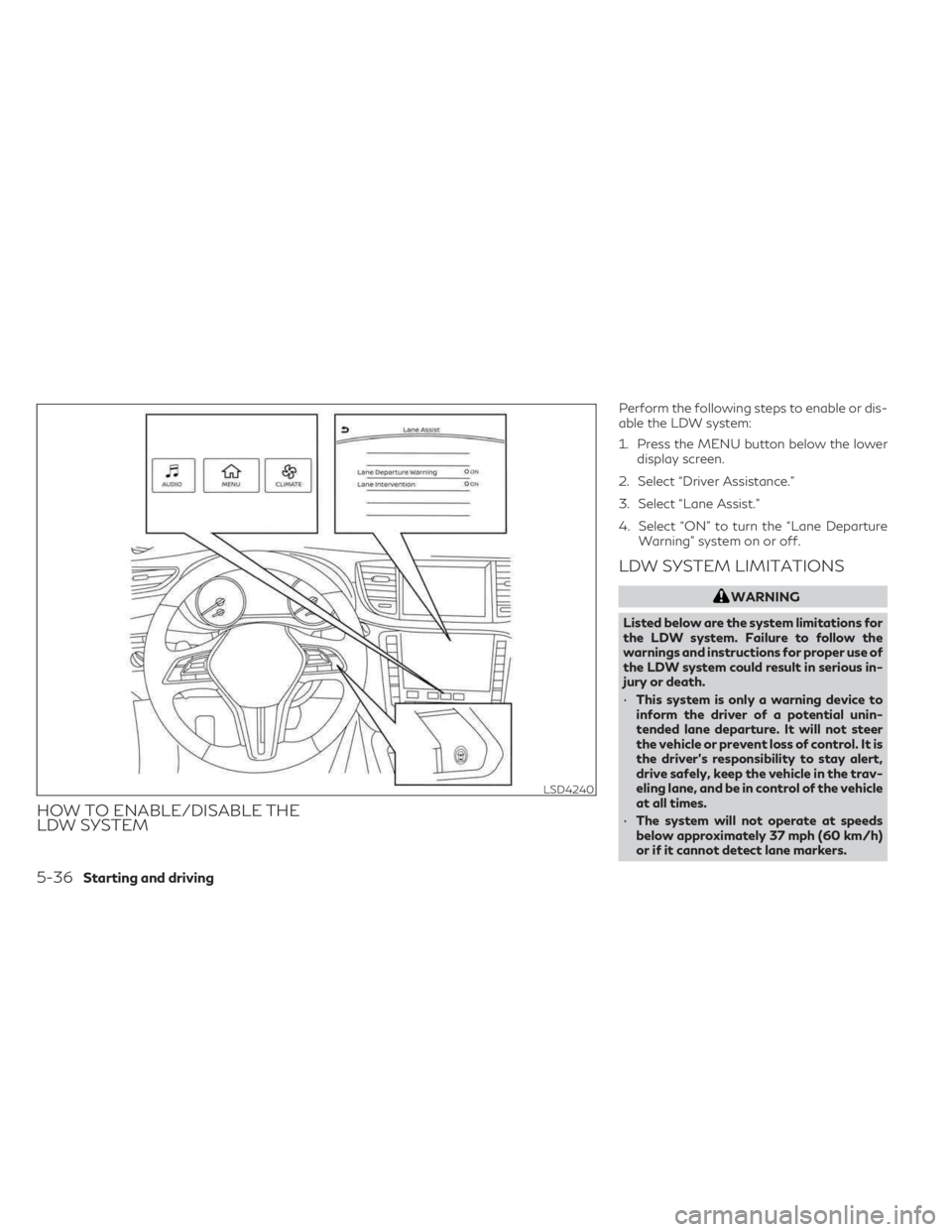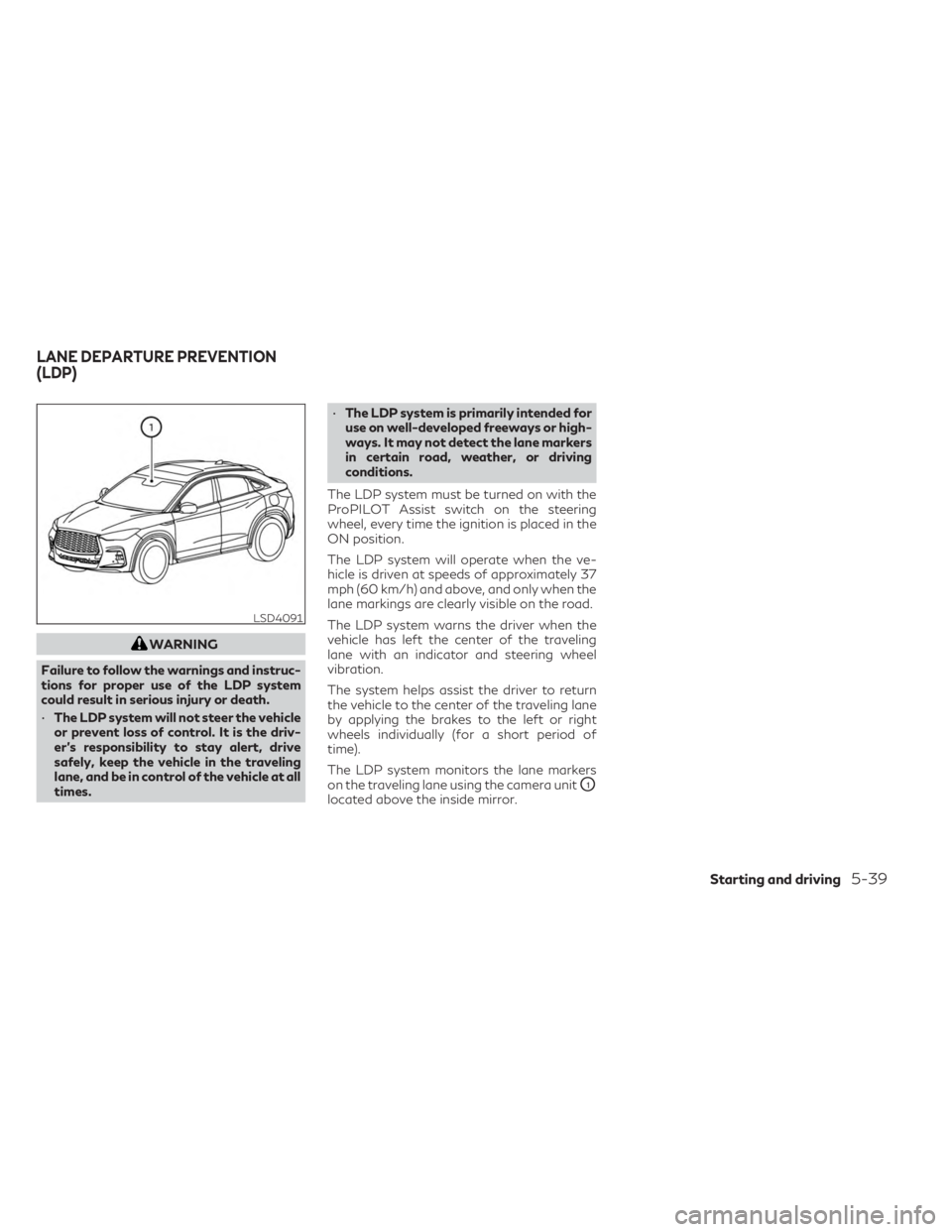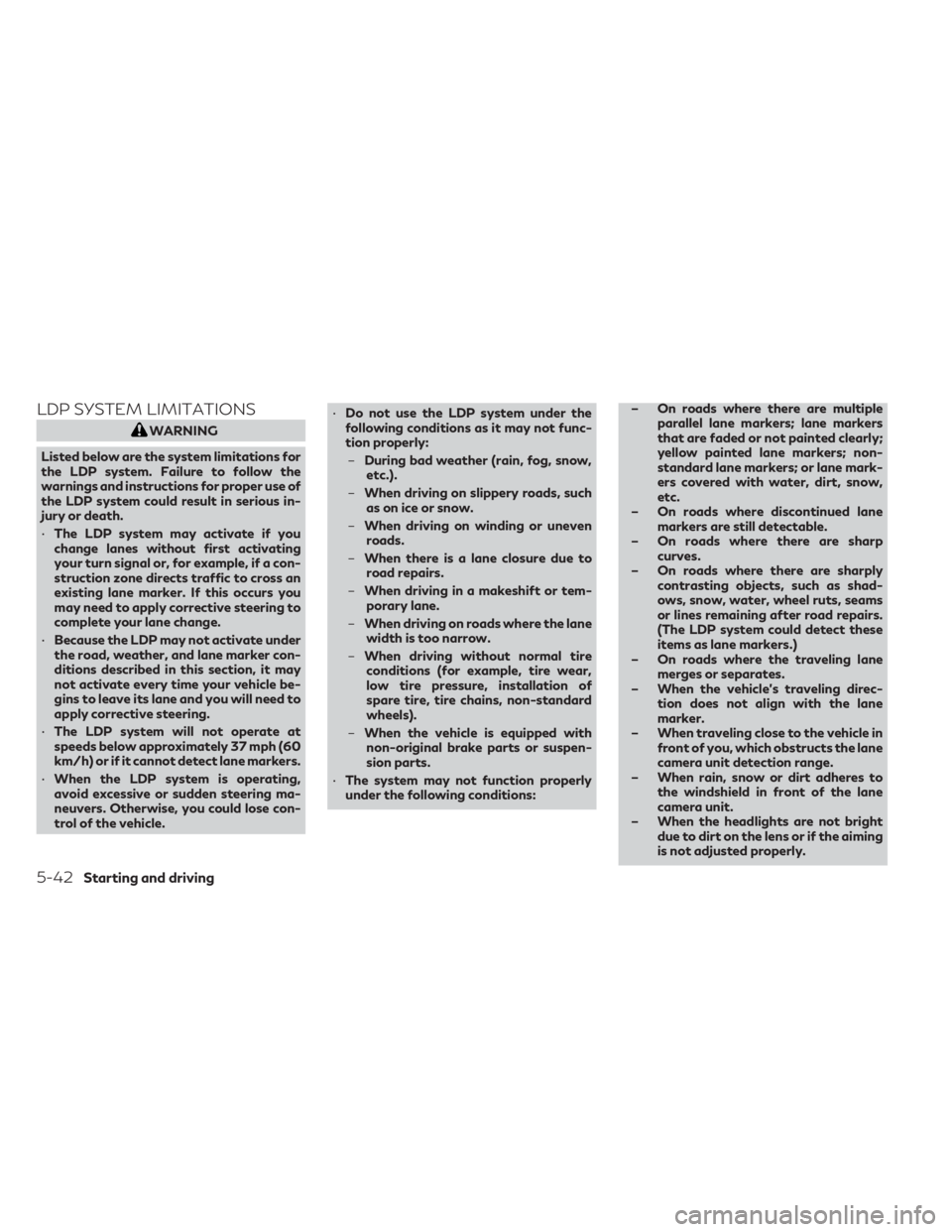warning INFINITI QX55 2023 Owners Manual
[x] Cancel search | Manufacturer: INFINITI, Model Year: 2023, Model line: QX55, Model: INFINITI QX55 2023Pages: 526, PDF Size: 5.75 MB
Page 273 of 526

WARNING
• If any of the following conditions occur,
the automatic brake hold function may
not function. Have the system checked
promptly. It is recommended that you
visit an INFINITI retailer for this service.
Failure to operate the vehicle in accor-
dance with these conditions could cause
the vehicle to move or roll away unex-
pectedly and result in serious personal
injury or property damage.
– A warning message appears.
– The indicator light on the automatic
brake hold switch does not illuminate
when the switch is pushed.
• The automatic brake hold function will
not be activated if the Slip indicator
light, electronic parking brake warning
light or master warning light illuminate
and the chassis control system fault
message appears in the vehicle informa-
tion display.
• To maintain the braking force to keep
the vehicle to a standstill, a noise may be
heard. This is not a malfunction.
HOW TO ACTIVATE/
DEACTIVATE THE AUTOMATIC
BRAKE HOLD FUNCTION
For additional information on activating and
deactivating the automatic brake hold func-
tion, refer to the instructions outlined in this
section.
How to activate the automatic
brake hold function
1. With the ignition switch in the ON posi- tion, push the automatic brake hold switch
O1. The indicator light on the automatic
brake hold switch
O2illuminates. 2. When the automatic brake hold function
goes into standby, the automatic brake
hold indicator light (white) illuminates.
To use the automatic brake hold function, the
following conditions need to be met:
• The driver’s seat belt is fastened.
• The electronic parking brake is released.
• The vehicle is not in the P (Park) position.
• The vehicle is not parked on a steep hill.
NOTE:
The automatic brake hold function retains
the last state even if the engine is restarted.
How to deactivate the automatic
brake hold function
While the automatic brake hold function is
activated, push the automatic brake hold
switch to turn off the automatic brake hold
indicator light and deactivate the automatic
brake hold function. To deactivate the auto-
matic brake hold function while the brake
force has been maintained by the automatic
brake hold function, depress the brake pedal
and push the automatic brake hold switch.
LSD2916
Starting and driving5-27
Page 274 of 526

WARNING
Make sure to firmly depress and hold the
brake pedal when turning off the auto-
matic brake hold function while the brake
force is applied. When the automatic brake
hold function is deactivated, the brake
force will be released. This could cause the
vehicle to move or roll away unexpectedly.
Failure to prevent the vehicle from rolling
may result in serious personal injury or
property damage.
HOW TO USE THE AUTOMATIC
BRAKE HOLD FUNCTION
For additional information on using the auto-
matic brake hold function, refer to the in-
structions outlined in this section.
To maintain braking force
automatically
With the automatic brake hold function acti-
vated and the automatic brake hold indicator
light (white) illuminated on the meter, depress
the braking pedal to stop the vehicle. The
automatic brake hold indicator illuminates
green on the meter, and the brake force is
automatically applied without your foot de-
pressed on the brake pedal. While the brake hold is maintained, the automatic brake hold
indicator light (green) illuminates on the
meter.
To start the vehicle from a standstill
With the vehicle not in the P (Park) or N
(Neutral) position, depress the accelerator
pedal while the brake force is maintained. The
brake force will automatically be released to
restart the vehicle.
The automatic brake hold indicator light
(white) illuminates and the automatic brake
hold returns to standby.
Parking
When the vehicle is in the P (Park) position
with the brake force maintained by the auto-
matic brake hold function, the parking brake
will automatically be applied and the brake
force of the automatic brake hold will be
released. The automatic brake hold indicator
light turns off. When the parking brake is
applied with the brake force maintained by
the automatic brake hold function, the brake
force of the automatic brake hold will be
released. The automatic brake hold indicator
light turns off.
NOTE:
• Under the following conditions, the elec-
tronic parking brake will automatically be
applied and the brake force of the auto-
matic brake hold will be released. The au-
tomatic brake hold indicator light turns
off.– The brake force is applied by the auto- matic brake hold function for 3 minutes
or longer.
– The vehicle is in the P (Park) position.
– The electronic parking brake is applied manually.
– The driver's seat belt is unfastened.
– The ignition switch is placed in the OFF position.
– A malfunction occurs in the automatic brake hold function.
• When the vehicle stops, but the brake force is not automatically applied, depress
the brake pedal firmly until the automatic
brake hold indicator light (green)
illuminates.
5-28Starting and driving
Page 275 of 526

Automatic brake hold function
display
The automatic brake hold function status is
shown by color in the “Chassis Control” mode
in the vehicle information display. For addi-
tional information, see “Vehicle information
display” (P. 2-19).
Also depending on the driving situations,
some warnings or indicators may be dis-
played in the vehicle information display. For
additional information, see “Vehicle informa-
tion display warnings and indicators”
(P. 2-25)Multiple driving modes can be selected by
using the INFINITI Drive Mode Selector
switch: STANDARD, SPORT, ECO and
PERSONAL.
When the INFINITI Drive Mode Selector se-
lects a mode, the mode may not switch
quickly. This is not a malfunction.
NOTE:
• The mode list will be turned off in approxi-
mately 5 seconds after the mode is
selected.
• Select the STANDARD mode for normal driving. If the driving mode cannot be switched using
the INFINITI Drive Mode Selector when the
ignition switch is in the ON position, have the
system checked by an INFINITI retailer.
STANDARD MODE
STANDARD mode is recommended for nor-
mal driving. Push the INFINITI Drive Mode
Selector switch until “STANDARD” appears
in the vehicle information display. STAN-
DARD mode will also be displayed in the
upper display.
This mode will be selected first each time the
engine is started.
SPORT MODE
The SPORT mode adjusts the engine and
transmission to enhance performance. Push
the INFINITI Drive Mode Selector switch to
the SPORT position. “SPORT” appears in the
vehicle information display. SPORT mode will
also be displayed in the upper display.
NOTE:
In the SPORT mode, fuel economy may be
reduced.
LSD3922LSD2917
INFINITI Drive Mode Selector switch
INFINITI DRIVE MODE SELECTOR
Starting and driving5-29
Page 278 of 526

WARNING
The TSR system is only intended to be a
support device to help provide the driver
with information. It is not a replacement
for the driver’s attention to traffic condi-
tions or responsibility to drive safely. It
cannot prevent accidents due to careless-
ness. It is the driver’s responsibility to stay
alert and drive safely at all times.
SYSTEM OPERATION
The Traffic Sign Recognition (TSR) system
displays the following types of road signs:
OASpeed sign detected (in Canada)
OBSpeed sign detected (in USA)
OCSpeed sign detected (no speed limit
detected)
OD“Do not pass” sign detected
CAUTION
• The TSR system is intended as an aid to
careful driving. It is the driver’s responsi-
bility to stay alert, drive safely, and ob-
serve all road regulations that currently
apply, including looking out for road
signs.
• The TSR system may not function prop-
erly under the following conditions:
– When the road sign is not clearly vis- ible, for example, due to damage or
weather conditions.
LSD3330LSD3378
5-32Starting and driving
Page 279 of 526

– When rain, snow or dirt adheres tothe windshield in front of the multi-
sensing camera unit.
– When the headlights are not bright, for example, due to dirt on the lens or
if the aiming is not adjusted properly.
– When strong light enters the camera unit. (For example, the light directly
shines on the front of the vehicle at
sunrise or sunset.)
– When a sudden change in brightness occurs. (For example, when the ve-
hicle enters or exits a tunnel or under
a bridge.)
– If there are deviations in relation to the navigation, for example due to
changes in the road routing.
– When overtaking buses or trucks with speed stickers.
TURNING THE TRAFFIC SIGN
RECOGNITION (TSR) SYSTEM ON
AND OFF
Perform the following steps to enable or dis-
able the TSR system.
1. Press the MENU button
O1below the
lower display screen.
2. Select “Driver Assistance.”
3. Select “Traffic Sign Assist.”
4. Select “ON” to turn the “Traffic Sign Rec- ognition” system on or off.
SYSTEM TEMPORARILY
UNAVAILABLE
If the vehicle is parked in direct sunlight under
high temperature conditions (over approxi-
mately 104°F [40°C]) and then started, the
TSR system may be deactivated automati-
cally. The “Not Available: High Camera
Temp.” warning message will appear in the
vehicle information display.
Action to take:
When the interior temperature is reduced, the
TSR system will resume operating
automatically.
SYSTEM MALFUNCTION
If the TSR system malfunctions, it will be
turned off automatically and the system
“Malfunction” warning message will appear
in the vehicle information display.
Action to take:
If the TSR “Malfunction” message appears,
pull off the road at a safe location and stop
the vehicle. Turn the engine off and restart
the engine. If the TSR “Malfunction” message
continues to appear, have the system
checked. It is recommended that you visit an
INFINITI retailer for this service.
LSD2965
Starting and driving5-33
Page 280 of 526

SYSTEM MAINTENANCE
The TSR system uses the same multi-sensing
front camera unit that is used by the Lane
Departure Warning (LDW) system, located in
front of the interior rearview mirror. For ad-
ditional information, see ”System mainte-
nance” (P. 5-38).
WARNING
Failure to follow the warnings and instruc-
tions for proper use of the LDW system
could result in serious injury or death.
• This system is only a warning device to
inform the driver of a potential unin-
tended lane departure. It will not steer
the vehicle or prevent loss of control. It is
the driver’s responsibility to stay alert,
drive safely, keep the vehicle in the trav-
eling lane, and be in control of the vehicle
at all times. The LDW system will operate when the ve-
hicle is driven at speeds of approximately 37
mph (60 km/h) and above, and only when the
lane markings are clearly visible on the road.
The LDW system monitors the lane markers
on the traveling lane using the camera unit
O1
located above the inside mirror.
The LDW system warns the driver with an
indicator in the vehicle information display
and the steering wheel will vibrate, indicating
that the vehicle is beginning to leave the driv-
ing lane. For additional information, see
“LDW system operation” (P. 5-35).
LSD4091
LANE DEPARTURE WARNING (LDW)
5-34Starting and driving
Page 281 of 526

LDW SYSTEM OPERATION
The LDW system provides a lane departure
warning function when the vehicle is driven at
speeds of approximately 37 mph (60 km/h)
and above and the lane markings are clear.
When the vehicle approaches either the left
or the right side of the traveling lane, the
steering wheel will vibrate and the LDW indi-
cator on the instrument panel will blink to
alert the driver.
The warning function will stop when the ve-
hicle returns inside of the lane markers.
LSD3040
Starting and driving5-35
Page 282 of 526

HOW TO ENABLE/DISABLE THE
LDW SYSTEM
Perform the following steps to enable or dis-
able the LDW system:
1. Press the MENU button below the lowerdisplay screen.
2. Select “Driver Assistance.”
3. Select “Lane Assist.”
4. Select “ON” to turn the “Lane Departure Warning” system on or off.
LDW SYSTEM LIMITATIONS
WARNING
Listed below are the system limitations for
the LDW system. Failure to follow the
warnings and instructions for proper use of
the LDW system could result in serious in-
jury or death.
• This system is only a warning device to
inform the driver of a potential unin-
tended lane departure. It will not steer
the vehicle or prevent loss of control. It is
the driver’s responsibility to stay alert,
drive safely, keep the vehicle in the trav-
eling lane, and be in control of the vehicle
at all times.
• The system will not operate at speeds
below approximately 37 mph (60 km/h)
or if it cannot detect lane markers.
LSD4240
5-36Starting and driving
Page 285 of 526

WARNING
Failure to follow the warnings and instruc-
tions for proper use of the LDP system
could result in serious injury or death.
• The LDP system will not steer the vehicle
or prevent loss of control. It is the driv-
er’s responsibility to stay alert, drive
safely, keep the vehicle in the traveling
lane, and be in control of the vehicle at all
times. •
The LDP system is primarily intended for
use on well-developed freeways or high-
ways. It may not detect the lane markers
in certain road, weather, or driving
conditions.
The LDP system must be turned on with the
ProPILOT Assist switch on the steering
wheel, every time the ignition is placed in the
ON position.
The LDP system will operate when the ve-
hicle is driven at speeds of approximately 37
mph (60 km/h) and above, and only when the
lane markings are clearly visible on the road.
The LDP system warns the driver when the
vehicle has left the center of the traveling
lane with an indicator and steering wheel
vibration.
The system helps assist the driver to return
the vehicle to the center of the traveling lane
by applying the brakes to the left or right
wheels individually (for a short period of
time).
The LDP system monitors the lane markers
on the traveling lane using the camera unit
O1
located above the inside mirror.
LSD4091
LANE DEPARTURE PREVENTION
(LDP)
Starting and driving5-39
Page 288 of 526

LDP SYSTEM LIMITATIONS
WARNING
Listed below are the system limitations for
the LDP system. Failure to follow the
warnings and instructions for proper use of
the LDP system could result in serious in-
jury or death.
• The LDP system may activate if you
change lanes without first activating
your turn signal or, for example, if a con-
struction zone directs traffic to cross an
existing lane marker. If this occurs you
may need to apply corrective steering to
complete your lane change.
• Because the LDP may not activate under
the road, weather, and lane marker con-
ditions described in this section, it may
not activate every time your vehicle be-
gins to leave its lane and you will need to
apply corrective steering.
• The LDP system will not operate at
speeds below approximately 37 mph (60
km/h) or if it cannot detect lane markers.
• When the LDP system is operating,
avoid excessive or sudden steering ma-
neuvers. Otherwise, you could lose con-
trol of the vehicle. •
Do not use the LDP system under the
following conditions as it may not func-
tion properly:
– During bad weather (rain, fog, snow,
etc.).
– When driving on slippery roads, such
as on ice or snow.
– When driving on winding or uneven
roads.
– When there is a lane closure due to
road repairs.
– When driving in a makeshift or tem-
porary lane.
– When driving on roads where the lane
width is too narrow.
– When driving without normal tire
conditions (for example, tire wear,
low tire pressure, installation of
spare tire, tire chains, non-standard
wheels).
– When the vehicle is equipped with
non-original brake parts or suspen-
sion parts.
• The system may not function properly
under the following conditions: – On roads where there are multiple
parallel lane markers; lane markers
that are faded or not painted clearly;
yellow painted lane markers; non-
standard lane markers; or lane mark-
ers covered with water, dirt, snow,
etc.
– On roads where discontinued lane markers are still detectable.
– On roads where there are sharp curves.
– On roads where there are sharply contrasting objects, such as shad-
ows, snow, water, wheel ruts, seams
or lines remaining after road repairs.
(The LDP system could detect these
items as lane markers.)
– On roads where the traveling lane merges or separates.
– When the vehicle’s traveling direc- tion does not align with the lane
marker.
– When traveling close to the vehicle in front of you, which obstructs the lane
camera unit detection range.
– When rain, snow or dirt adheres to the windshield in front of the lane
camera unit.
– When the headlights are not bright due to dirt on the lens or if the aiming
is not adjusted properly.
5-42Starting and driving